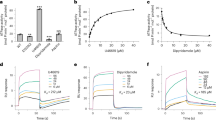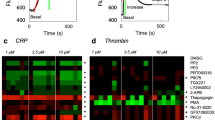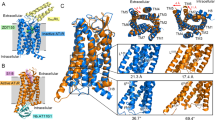Abstract
In response to adenosine 5′-diphosphate, the P2Y1 receptor (P2Y1R) facilitates platelet aggregation, and thus serves as an important antithrombotic drug target. Here we report the crystal structures of the human P2Y1R in complex with a nucleotide antagonist MRS2500 at 2.7 Å resolution, and with a non-nucleotide antagonist BPTU at 2.2 Å resolution. The structures reveal two distinct ligand-binding sites, providing atomic details of P2Y1R's unique ligand-binding modes. MRS2500 recognizes a binding site within the seven transmembrane bundle of P2Y1R, which is different in shape and location from the nucleotide binding site in the previously determined structure of P2Y12R, representative of another P2YR subfamily. BPTU binds to an allosteric pocket on the external receptor interface with the lipid bilayer, making it the first structurally characterized selective G-protein-coupled receptor (GPCR) ligand located entirely outside of the helical bundle. These high-resolution insights into P2Y1R should enable discovery of new orthosteric and allosteric antithrombotic drugs with reduced adverse effects.
This is a preview of subscription content, access via your institution
Access options
Subscribe to this journal
Receive 51 print issues and online access
$199.00 per year
only $3.90 per issue
Buy this article
- Purchase on Springer Link
- Instant access to full article PDF
Prices may be subject to local taxes which are calculated during checkout




Similar content being viewed by others
References
Abbracchio, M. P. et al. International Union of Pharmacology LVIII: update on the P2Y G protein-coupled nucleotide receptors: from molecular mechanisms and pathophysiology to therapy. Pharmacol. Rev. 58, 281–341 (2006)
Gachet, C. P2 receptors, platelet function and pharmacological implications. Thromb. Haemost. 99, 466–472 (2008)
Jacobson, K. A., Deflorian, F., Mishra, S. & Costanzi, S. Pharmacochemistry of the platelet purinergic receptors. Purinergic Signal. 7, 305–324 (2011)
Jin, J. & Kunapuli, S. P. Coactivation of two different G protein-coupled receptors is essential for ADP-induced platelet aggregation. Proc. Natl Acad. Sci. USA 95, 8070–8074 (1998)
Zerr, M. et al. Major contribution of the P2Y1 receptor in purinergic regulation of TNFalpha-induced vascular inflammation. Circulation 123, 2404–2413 (2011)
Fam, S. R., Gallagher, C. J. & Salter, M. W. P2Y1 purinoceptor-mediated Ca2+ signaling and Ca2+ wave propagation in dorsal spinal cord astrocytes. J. Neurosci. 20, 2800–2808 (2000)
Neary, J. T., Kang, Y., Willoughby, K. A. & Ellis, E. F. Activation of extracellular signal-regulated kinase by stretch-induced injury in astrocytes involves extracellular ATP and P2 purinergic receptors. J. Neurosci. 23, 2348–2356 (2003)
Kim, H. S. et al. 2-Substitution of adenine nucleotide analogues containing a bicyclo[3.1.0]hexane ring system locked in a northern conformation: enhanced potency as P2Y1 receptor antagonists. J. Med. Chem. 46, 4974–4987 (2003)
Hechler, B. et al. MRS2500 [2-iodo-N6-methyl-(N)-methanocarba-2′-deoxyadenosine-3′,5′-bisphosphate], a potent, selective, and stable antagonist of the platelet P2Y1 receptor with strong antithrombotic activity in mice. J. Pharmacol. Exp. Ther. 316, 556–563 (2006)
Chao, H. et al. Discovery of 2-(phenoxypyridine)-3-phenylureas as small molecule P2Y1 antagonists. J. Med. Chem. 56, 1704–1714 (2013)
Zhang, C. et al. High-resolution crystal structure of human protease-activated receptor 1. Nature 492, 387–392 (2012)
White, J. F. et al. Structure of the agonist-bound neurotensin receptor. Nature 490, 508–513 (2012)
Wu, B. et al. Structures of the CXCR4 chemokine GPCR with small-molecule and cyclic peptide antagonists. Science 330, 1066–1071 (2010)
Tan, Q. et al. Structure of the CCR5 chemokine receptor-HIV entry inhibitor maraviroc complex. Science 341, 1387–1390 (2013)
Wu, H. et al. Structure of the human kappa-opioid receptor in complex with JDTic. Nature 485, 327–332 (2012)
Ballesteros, J. & Weinstein, H. Integrated methods for the construction of three-dimensional models and computational probing of structure-function relations in G protein-coupled receptors. Methods Neurosci. 25, 366–428 (1995)
Zhang, J. et al. Agonist-bound structure of the human P2Y12 receptor. Nature 509, 119–122 (2014)
Zhang, K. et al. Structure of the human P2Y12 receptor in complex with an antithrombotic drug. Nature 509, 115–118 (2014)
Costanzi, S., Mamedova, L., Gao, Z. G. & Jacobson, K. A. Architecture of P2Y nucleotide receptors: structural comparison based on sequence analysis, mutagenesis, and homology modeling. J. Med. Chem. 47, 5393–5404 (2004)
Moro, S. et al. Human P2Y1 receptor: molecular modeling and site-directed mutagenesis as tools to identify agonist and antagonist recognition sites. J. Med. Chem. 41, 1456–1466 (1998)
Guo, D., von Kügelgen, I., Moro, S., Kim, Y. C. & Jacobson, K. A. Evidence for the recognition of non-nucleotide antagonists within the transmembrane domains of the human P2Y1 receptor. Drug Dev. Res. 57, 173–181 (2002)
Qiao, J. X. et al. Conformationally constrained ortho-anilino diaryl ureas: discovery of 1-(2-(1′-neopentylspiro[indoline-3,4′-piperidine]-1-yl)phenyl)-3-(4-(trifluoromethoxy)phenyl)urea, a potent, selective, and bioavailable P2Y1 antagonist. J. Med. Chem. 56, 9275–9295 (2013)
Yang, W. et al. Discovery of 4-aryl-7-hydroxyindoline-based P2Y1 antagonists as novel antiplatelet agents. J. Med. Chem. 57, 6150–6164 (2014)
Wang, T. C. et al. Discovery of diarylurea P2Y1 antagonists with improved aqueous solubility. Bioorg. Med. Chem. Lett. 23, 3239–3243 (2013)
Hildebrand, P. W. et al. A ligand channel through the G protein coupled receptor opsin. PLoS ONE 4, e4382 (2009)
Hanson, M. A. et al. Crystal structure of a lipid G protein-coupled receptor. Science 335, 851–855 (2012)
Srivastava, A. et al. High-resolution structure of the human GPR40 receptor bound to allosteric agonist TAK-875. Nature 513, 124–127 (2014)
Park, J. H., Scheerer, P., Hofmann, K. P., Choe, H. W. & Ernst, O. P. Crystal structure of the ligand-free G-protein-coupled receptor opsin. Nature 454, 183–187 (2008)
Rasmussen, S. G. et al. Structure of a nanobody-stabilized active state of the beta(2) adrenoceptor. Nature 469, 175–180 (2011)
Xu, F. et al. Structure of an agonist-bound human A2A adenosine receptor. Science 332, 322–327 (2011)
Chun, E. et al. Fusion partner toolchest for the stabilization and crystallization of G protein-coupled receptors. Structure 20, 967–976 (2012)
Caffrey, M. & Cherezov, V. Crystallizing membrane proteins using lipidic mesophases. Nature Protocols 4, 706–731 (2009)
Kabsch, W. Xds. Acta Crystallogr. D 66, 125–132 (2010)
McCoy, A. J. et al. Phaser crystallographic software. J. Appl. Crystallogr. 40, 658–674 (2007)
Murshudov, G. N., Vagin, A. A. & Dodson, E. J. Refinement of macromolecular structures by the maximum-likelihood method. Acta Crystallogr. D 53, 240–255 (1997)
Smart, O. S. et al. Exploiting structure similarity in refinement: automated NCS and target-structure restraints in BUSTER. Acta Crystallogr. D 68, 368–380 (2012)
Emsley, P., Lohkamp, B., Scott, W. G. & Cowtan, K. Features and development of Coot. Acta Crystallogr. D 66, 486–501 (2010)
Acknowledgements
This work was supported by the National Basic Research Program of China grants 2012CB518000, 2014CB910400 and 2012CB910400 (Q.Z., B.W.), CAS Strategic Priority Research Program XDB08020300 (B.W.), the National Science Foundation of China grants 31422017 (B.W.), 31370729 (Q.Z.) and 91313000 (H.J.), the National Science and Technology Major Project 2013ZX09507001 (H.J., Q.Z., B.W.), NIDDK, NIH Intramural Research Program grant Z01 DK031116-26 (K.A.J.), and the National Institutes of Health grant U54 GM094618 (V.C., V.K., R.C.S.). The authors thank A. Walker for assistance with manuscript preparation and S. M. Moss for technical assistance. The synchrotron radiation experiments were performed at the BL41XU of Spring-8 with approval of the Japan Synchrotron Radiation Research Institute (JASRI) (proposal no. 2014A1094 and 2014B1056). We thank the beamline staff members of the BL41XU for help with X-ray data collection.
Author information
Authors and Affiliations
Contributions
D.Z. optimized the construct, developed the purification procedure and purified the P2Y1R proteins for crystallization, performed crystallization trials and optimized crystallization conditions. Z.-G.G. designed, performed and analysed ligand binding and competition assays of wild-type and mutant P2Y1R. K.Z. helped with construct and crystal optimization, and collected diffraction data. E.K. and J.W. helped with ligand synthesis of P2Y1R. S.C. performed and analysed ligand-binding assays. S.P. performed and analysed docking assays. C.Y. and L.M. expressed the P2Y1R proteins. W.Z. developed the initial expression and purification protocol for P2Y1R. G.W.H. helped to analyse the structures. H.L. oversaw ligand synthesis of P2Y1R. V.C. and V.K. helped to analyse the structures and assisted with manuscript preparation. H.J. and R.C.S. oversaw structure analysis/interpretation of P2Y1R. K.A.J. oversaw, designed and analysed ligand-binding assays, oversaw ligand synthesis, and assisted with manuscript preparation. Q.Z. and B.W. initiated the project, planned and analysed experiments, solved the structures, supervised the research and wrote the manuscript.
Corresponding authors
Ethics declarations
Competing interests
The authors declare no competing financial interests.
Extended data figures and tables
Extended Data Figure 1 Crystal packing of P2Y1R–MRS2500 and P2Y1R–BPTU complexes.
a, Overall structure of the P2Y1R–MRS2500 complex. P2Y1R and rubredoxin are coloured in blue and grey, respectively. MRS2500 is shown in magenta stick representation. b, c, Crystal packing of the P2Y1R–MRS2500 complex shown in two different views. d, Overall structure of the P2Y1R–BPTU complex. P2Y1R and rubredoxin are coloured in orange and grey, respectively. BPTU is shown in green stick representation. e, f, Crystal packing of the P2Y1R–BPTU complex shown in two different views. Lipid molecules are shown in white line representation.
Extended Data Figure 2 Structural comparison of P2Y1R structures.
a, Comparison of the HR3.50Y motif in P2Y1R and the DR3.50Y motif in A2A adenosine receptor (A2AAR, PDB ID: 3EML). P2Y1R and A2AAR are shown in cartoon representation, and coloured in orange and purple, respectively. Residues at positions 3.49 and 3.50 are shown as sticks. The hydrogen bond formed by R1493.50 and A3277.56 in P2Y1R is displayed as a blue dashed line. b, Comparison of the P2Y1R–MRS2500 complex and the P2Y1R–BPTU complex structures. The P2Y1R–MRS2500 structure is coloured in blue, and the P2Y1R–BPTU structure is orange. The ligands MRS2500 and BPTU are shown in stick representation with magenta and green carbons, respectively. The residues R195 in both structures are shown as sticks. The salt-bridge between MRS2500 and R195 in the P2Y1R–MRS2500 structure is displayed as a red dashed line. The red arrow indicates the shift at the β-hairpin tip of ECL2 towards the centre axis of the helical bundle in the P2Y1R–MRS2500 structure compared to the P2Y1R–BPTU structure.
Extended Data Figure 3 Electron density of MRS2500 and BPTU.
a, MRS2500 is shown in stick representation with magenta carbons. The receptor is shown in blue cartoon representation. Electron density is contoured at 1.0σ from an |2Fo| - |Fc| map, and coloured in green. The disulfide bonds are shown as yellow sticks. b, BPTU is shown in stick representation with green carbons. The receptor is shown in orange cartoon representation. Electron density is contoured at 1.0σ from an |2Fo| - |Fc| map, and coloured in blue. The disulfide bond is shown as a red stick.
Extended Data Figure 4 Chemical structures of different P2Y1R ligands that are used in the paper.
a, N6 -methyl-2′-deoxyadenosine-3′,5′-bisphosphate (MRS2179); b, 2MeSADP.
Extended Data Figure 5 Inhibition of [3H]2MeSADP binding by MRS2500 and BPTU.
Data shown are from a representative experiment performed in duplicate. a–d, Inhibition of [3H]2MeSADP binding to membrane preparations from Sf9 cells expressing mutant P2Y1Rs by MRS2500 (a, b) and BPTU (c, d). Construct 1 is the P2Y1R construct used for MRS2500 co-crystallization. Construct 2 is the P2Y1R construct used for BPTU co-crystallization. The Ki values for MRS2500 or BPTU from at least three independent experiments are listed in Extended Data Table 2. The affinity of MRS2500 at Construct 1 is 18.4 ± 1.5 nM, which is significantly different from its affinity at the mutant Y303F (2880 ± 854 nM) (P < 0.05, unpaired t-test). The affinity of BPTU for construct 1 is 161 ± 47 nM, which is not significantly different from its affinity for Y303F (309 ± 36 nM) (P > 0.05, unpaired t-test). e, f, Inhibition of [3H]2MeSADP binding to membrane preparations from COS-7 cells expressing WT and mutant P2Y1Rs by MRS2500 (e) and BPTU (f).
Extended Data Figure 6 Structural comparison of the ligand-binding sites between P2Y1R and other class A GPCRs.
a, Comparison of the ligand-binding sites between P2Y1R–MRS2500 and P2Y12R–2MeSADP. Only P2Y1R (blue) is shown in cartoon and surface representations. The ligands MRS2500 and 2MeSADP are shown as sticks with magenta and yellow carbons, respectively. The red arrow points to the small cavity that partially overlaps with the position of the adenine ring of 2MeSADP bound to P2Y12R in the P2Y1R–MRS2500 structure. b, Comparison of the small-molecule ligand-binding sites of P2Y1R, β2 adrenergic receptor (β2AR, PDB ID: 2RH1), A2AAR (PDB ID: 3EML), CXCR4 (PDB ID: 3ODU), protease-activated receptor 1 (PAR1, PDB ID: 3VW7), δ-opioid receptor (dOR, PDB ID: 4EJ4) and P2Y12R (PDB ID: 4NTJ). Only P2Y1R helices are shown (blue). The ligands MRS2500 (for P2Y1R, magenta), carazolol (for β2AR, orange), ZM241385 (for A2AAR, red), IT1t (for CXCR4, wheat), vorapaxar (for PAR1, yellow), naltrindole (for dOR, green) and AZD1283 (for P2Y12R, cyan) are shown in stick representation. c, Top view of the antagonist binding sites of P2Y1R (blue), P2Y12R (cyan) and PAR1 (yellow). The antagonists, MRS2500, AZD1283 and vorapaxar are shown in stick representation and coloured as in panel b.
Extended Data Figure 7 Docking poses of selected BPTU derivatives.
Superposition of the crystallographic pose of BPTU (green carbons) with the docking poses obtained for: BPTU (yellow carbons), compound 3l from ref. 22 (pink carbons) and compound 2d from ref. 23 (cyan carbons). The P2Y1R–BPTU structure is shown in cartoon representation and coloured in orange. P2Y1R residues (grey carbons) involved in ligand binding are shown in stick representation. Hydrogen bonds are shown as red dashed lines. All the compounds overlay very well with the BPTU crystal pose, showing hydrogen bonds with the mainchain carbonyl of L1022.55. An additional hydrogen bond with Q1273.28 helps to stabilize the binding mode of compound 2d.
Extended Data Figure 8 The allosteric effects of BPTU on [3H]2MeSADP dissociation.
Data shown are from three independent experiments. a, b, The allosteric effects of BPTU on [3H]2MeSADP dissociation from the membrane preparations from Sf9 cells expressing construct 2 (a, the P2Y1R construct used for BPTU co-crystallization) and the A1062.59W mutant P2Y1R (b). The dissociation of [3H]2MeSADP was tested in the absence (white circles)or presence (white squares) of 10 µM BPTU. c, d, The allosteric effects of BPTU on [3H]2MeSADP dissociation from the membrane preparations from COS-7 cells expressing WT (c) and the A1062.59W mutant P2Y1R (d).
Rights and permissions
About this article
Cite this article
Zhang, D., Gao, ZG., Zhang, K. et al. Two disparate ligand-binding sites in the human P2Y1 receptor. Nature 520, 317–321 (2015). https://doi.org/10.1038/nature14287
Received:
Accepted:
Published:
Issue Date:
DOI: https://doi.org/10.1038/nature14287
This article is cited by
-
Machine learning-aided search for ligands of P2Y6 and other P2Y receptors
Purinergic Signalling (2024)
-
Pharmacological interaction and immune response of purinergic receptors in therapeutic modulation
Purinergic Signalling (2023)
-
Pharmacological characterization of P2Y receptor subtypes – an update
Purinergic Signalling (2023)
-
Structure–activity features of purines and their receptors: implications in cell physiopathology
Molecular Biomedicine (2022)
-
Structural basis for recognition of antihistamine drug by human histamine receptor
Nature Communications (2022)
Comments
By submitting a comment you agree to abide by our Terms and Community Guidelines. If you find something abusive or that does not comply with our terms or guidelines please flag it as inappropriate.



